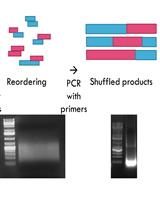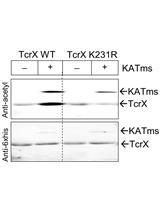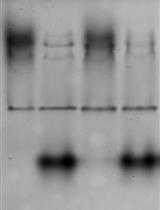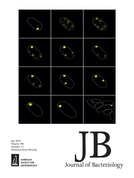- Submit a Protocol
- Receive Our Alerts
- Log in
- /
- Sign up
- My Bio Page
- Edit My Profile
- Change Password
- Log Out
- EN
- EN - English
- CN - 中文
- Protocols
- Articles and Issues
- For Authors
- About
- Become a Reviewer
- EN - English
- CN - 中文
- Home
- Protocols
- Articles and Issues
- For Authors
- About
- Become a Reviewer
Biotinylation and Purification of Surface-exposed Helicobacter pylori Proteins
Published: Vol 5, Iss 8, Apr 20, 2015 DOI: 10.21769/BioProtoc.1455 Views: 8522
Reviewed by: Anonymous reviewer(s)

Protocol Collections
Comprehensive collections of detailed, peer-reviewed protocols focusing on specific topics
Related protocols

Characterization of Protein Domain Function via in vitro DNA Shuffling
Kathy Hiu Laam Po [...] Sheng Chen
Jun 5, 2018 6541 Views

In vitro and in vivo Assessment of Protein Acetylation Status in Mycobacteria
Krishna K. Singh [...] Deepak K. Saini
Jul 5, 2019 5617 Views

In vitro Glutamylation Inhibition of Ubiquitin Modification and Phosphoribosyl-Ubiquitin Ligation Mediated by Legionella pneumophila Effectors
Alan G. Sulpizio [...] Yuxin Mao
Nov 5, 2020 3832 Views
Abstract
Interactions between pathogenic bacteria and host cells are often mediated by proteins found on the surfaces of the bacteria. The Gram-negative bacterium Helicobacter pylori is predicted to produce at least 50 surface-exposed outer membrane proteins, but there has been relatively little progress in experimentally analyzing the cell-surface proteome of this organism. Herein, we describe in detail a protocol that allows biotinylation and purification of surface-exposed H. pylori proteins. A comparative analysis of surface-exposed proteins identified by this biotinylation-based approach and by several other independent methods is described in a recent publication (Voss et al., 2014).
Keywords: Outer membrane proteinsMaterials and Reagents
- Tryptone (BD, catalog number: 211705 )
- Proteose peptone #3 (BD, catalog number: 211693 )
- Yeast Extract (BD, catalog number: 212720 )
- NaCl (Acros Organics, catalog number: 207790250 )
- Dextrose (Thermo Fisher Scientific, catalog number: D14-212 )
- Fetal bovine serum (Atlanta Biologicals, catalog number: S11150 )
- Tris Base (Thermo Fisher Scientific, catalog number: BP152 )
- Na2HPO4 (Sigma-Aldrich, catalog number: S5136 )
- KCl (Sigma-Aldrich, catalog number: P-9333 )
- 10x PBS (Corning, catalog number: 46-013-CM )
- MgCl2.6H2O (Thermo Fisher Scientific, catalog number: M35 )
- CaCl2 (Sigma-Aldrich, catalog number: C-4901 )
- EDTA-Na2.2H2O (Sigma-Aldrich, catalog number: E4884 )
- D-biotin (Sigma-Aldrich, catalog number: B4501 )
- S-NHS-LC-Biotin (Thermo Fisher Scientific, catalog number: 21335 )
- Zwittergent 3-14 (Fluka, catalog number: 40772 )
- Protease inhibitor cocktail (Roche Diagnostics, catalog number: 04693159001 )
- Monomeric avidin magnetic beads, Blocking buffer, Regeneration buffer (Bioclone, catalog number: MMI-101 )
- 100% (w/v) TCA (Sigma-Aldrich, catalog number: T0699 )
- Acetone (Thermo Fisher Scientific, catalog number: A16F )
- Brucella broth (see Recipes)
- Biotinylation buffer (see Recipes)
- TNKCM (see Recipes)
- Lysis buffer (see Recipes)
- TKE (see Recipes)
- TKEZ (see Recipes)
- Sample dilution buffer (see Recipes)
- Blocking buffer (see Recipes)
- Regeneration buffer (see Recipes)
- Wash buffer (see Recipes)
- Elution buffer (see Recipes)
Equipment
- CO2 shaking incubator (ATR Biotech, model: AJ125B )
- Bench top centrifuge (Thermo Fisher Scientific, catalog number: 75004381 )
- Sonicator (Thermo Fisher Scientific, catalog number: FB505 )
- Bench top centrifuge (Eppendorf, catalog number: 5424 )
- Ultracentrifuge (Beckman Coulter, catalog number: A94469 )
- Barnstead/Thermolyne Labquake Shaker Rotisserie (Labquake, catalog number: C400110 )
- DynaMagTM- Spin Magnet (Life Technologies, catalog number: 12320D )
Procedure
- On-cell biotinylation
- Grow 25 ml of H. pylori liquid culture in Brucella broth containing 10% fetal bovine serum until late-log phase (OD600 = 0.7) at 37 °C.
- Pellet all bacteria from the 25 ml culture at 3,500 x g for 20 min at 4 °C, and discard media.
- Resuspend bacterial pellet in 10 ml Biotinylation buffer.
- Pellet bacteria at 3,500 x g for 10 min at 4 °C, and discard buffer.
- Resuspend bacterial pellet in 10 ml Biotinylation buffer.
- Add S-NHS-LC-biotin to a final concentration of 200 μM.
- Incubate on ice for 30 min.
- Quench reaction by adding 20 ml TNKCM, incubate at room temperature for 10 min.
- Pellet bacteria at 3,500 x g for 20 min at 4 °C, and discard buffer.
- Resuspend bacterial pellet in 10 ml TNKCM, pellet bacteria at 3,500 x g for 10 min at 4 °C, and discard buffer. Repeat two more times for a total of three washes.
- Grow 25 ml of H. pylori liquid culture in Brucella broth containing 10% fetal bovine serum until late-log phase (OD600 = 0.7) at 37 °C.
- Bacterial lysis and subcellular fractionation
- Resuspend bacterial pellet in 3 ml lysis buffer + protease inhibitor cocktail.
- Sonicate (4 times, 10 sec each, at 25% maximum amplitude) on ice to lyse bacteria, pellet intact bacteria at 7,000 x g for 10 min, collect lysis supernatant.
- Pellet membranes by spinning lysate at 40,000 x g for 30 min at 4 °C.
- Discard supernatant.
- Rinse membrane pellet with TKE three times.
- Collect membrane pellet by scraping with a clean pipette tip and resuspend in 1 ml TKEZ + protease inhibitor cocktail.
- Solubilize for 1 h at 4 °C with head-over-head mixing.
- Spin at 100,000 x g for 1 h at 4 °C, collect supernatant.
- Resuspend bacterial pellet in 3 ml lysis buffer + protease inhibitor cocktail.
- Isolation and enrichment of biotinylated proteins
- Dilute the supernatant 10x with sample dilution buffer (resulting in a volume of 10 ml).
- Aliquot 50 μl of avidin magnetic bead suspension into a microfuge tube.
- Place tube on magnet, remove storage buffer.
- Resuspend beads in 500 μl PBS, place on magnet and discard buffer.
- Resuspend beads in 200 μl blocking buffer.
- Incubate beads for 10 min with head-over-head mixing.
- Place on magnet, discard buffer, resuspend beads in 400 μl regeneration buffer.
- Place on magnet, discard buffer, resuspend beads in 500 μl wash buffer.
- Place on magnet, discard buffer.
- Add 1 ml aliquot of sample described in step C19 to equilibrated beads and incubate at room temperature with head over head mixing for 10 min. Then place the tube on magnet, discard supernatant, and apply another 1 ml aliquot. Repeat this procedure until the entire 10 ml of sample is applied to the beads.
- After entire 10 ml sample from step C19 has been incubated with the magnetic beads, resuspend beads in 1 ml wash buffer, and incubate for 5 min with head-over-head mixing. Then place the tube on magnet and discard supernatant. Repeat two more times for a total of three washes.
- Resuspend beads in 1 ml wash buffer and transfer the suspended beads to a clean tube.
- To elute biotinylated proteins: place the bead suspension on magnet, discard supernatant, resuspend beads in 1 ml elution buffer, and incubate at room temperature for 10 min with head-over-head mixing.
- Place the tube on magnet and save the supernatant. Add another 1 ml elution buffer to the beads and incubate at room temperature for 10 min with head over head mixing. Then place on the magnet and again save the supernatant. Repeat this procedure once more, resulting in a total elution volume of 3 ml.
- Precipitate proteins by adding 1 ml TCA to the 3 ml elution (25% final concentration TCA).
- Vortex to mix, incubate at 4 °C for at least 30 min. (Overnight storage at 4 °C is possible at this stage).
- Spin at 21,000 x g for 30 min at 4 °C, discard supernatant.
- Add 1 ml ice cold acetone, spin at 21,000 x g at 4 °C for 10 min, discard supernatant, repeat once for a total of two acetone washes.
- Air dry pellet at room temperature, store at -20 °C until needed.
- Dilute the supernatant 10x with sample dilution buffer (resulting in a volume of 10 ml).
Notes
- Samples can be initially analyzed by SDS-PAGE and silver staining, or by Western blotting if suitable antisera reactive with H. pylori outer membrane proteins are available. A comprehensive identification of the proteins present in preparations of purified biotinylated proteins can be accomplished by mass spectrometry. Results obtained using this method for biotinylation and purification of surface-exposed H. pylori proteins, along with a comparative analysis of results obtained using other methods, are described in detail in Voss et al. (2014). The use of multiple methods for identifying surface-exposed proteins helps to minimize false-positive results.
- In parallel with the purification of biotinylated proteins from biotinylated bacteria, we recommend that non-biotinylated bacteria should be processed as a control as described previously in Voss et al. (2014). This comparative approach minimizes false-positive results that can arise due to non-specific protein binding to beads.
Recipes
- Brucella broth
10 g/L tryptone
10 g/L proteose peptone #3
5 g/L NaCl
2 g/L yeast extract
1 g/L dextrose
- Biotinylation buffer
1x PBS
1 mM CaCl2
0.5 mM MgCl2
1.6 mM D-biotin
pH 7.4
- TNKCM (for quenching of S-NHS-LC-biotin and washing bacteria)
50 mM Tris (pH 7.4)
100 mM NaCl
27 mM KCl
1 mM CaCl2
0.5 mM MgCl2
- Lysis buffer
50 mM Tris (pH 7.4)
1 mM MgCl2
- TKE (for rinsing membrane pellet)
50 mM Tris (pH 7.4)
150 mM KCl
10 mM EDTA
- TKEZ (for preferentially solubilizing outer membrane proteins)
50 mM Tris (pH 7.4)
150 mM KCl
10 mM EDTA
2% Zwittergent 3-14
- Sample dilution buffer
100 mM Na2HPO4 (pH 7.4)
150 mM NaCl
- Blocking buffer
100 mM Na2HPO4 (pH 7)
150 mM NaCl
2 mM D-biotin
- Regeneration buffer
100 mM glycine (pH 2.8)
- Wash buffer (for washing magnetic beads)
100 mM Na2HPO4 (pH 7.4)
150 mM NaCl
0.2% Zwittergent 3-14
- Elution buffer
100 mM Na2HPO4 (pH 7.4)
150 mM NaCl
0.2% Zwittergent 3-14
5 mM D-biotin
Acknowledgments
The biotinylation protocol described here and in Voss et al. (2014) is modified from a protocol described in Sabarth et al. (2002). Supported by the Department of Veterans Affairs, Merit Review grant 2I01 BX000627.
References
- Sabarth, N., Lamer, S., Zimny-Arndt, U., Jungblut, P. R., Meyer, T. F. and Bumann, D. (2002). Identification of surface proteins of Helicobacter pylori by selective biotinylation, affinity purification, and two-dimensional gel electrophoresis. J Biol Chem 277(31): 27896-27902.
- Voss, B. J., Gaddy, J. A., McDonald, W. H. and Cover, T. L. (2014). Analysis of surface-exposed outer membrane proteins in Helicobacter pylori. J Bacteriol 196(13): 2455-2471.
Article Information
Copyright
© 2015 The Authors; exclusive licensee Bio-protocol LLC.
How to cite
Voss, B. J. and Cover, T. L. (2015). Biotinylation and Purification of Surface-exposed Helicobacter pylori Proteins. Bio-protocol 5(8): e1455. DOI: 10.21769/BioProtoc.1455.
Category
Microbiology > Microbial biochemistry > Protein > Modification
Biochemistry > Protein > Isolation and purification
Biochemistry > Protein > Labeling
Do you have any questions about this protocol?
Post your question to gather feedback from the community. We will also invite the authors of this article to respond.
Share
Bluesky
X
Copy link









